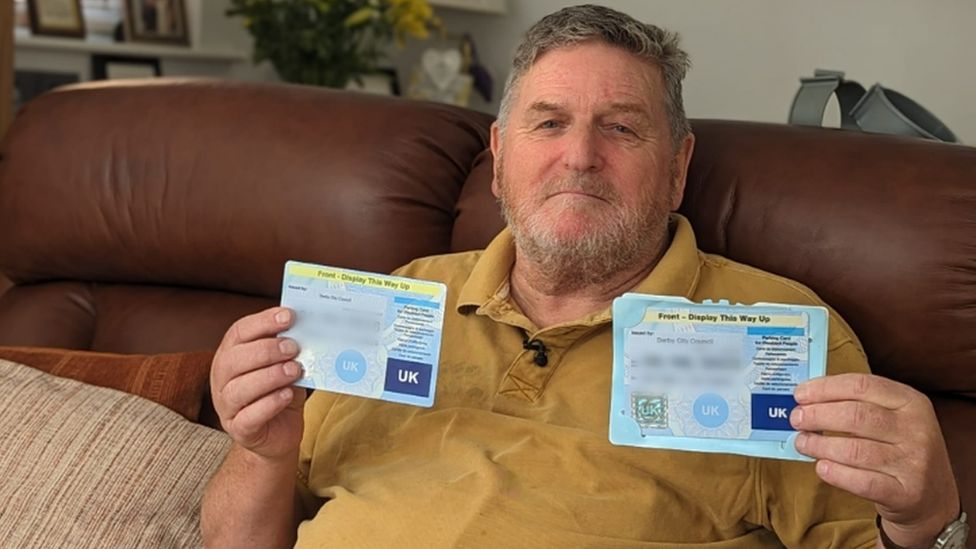Derby council’s automated phone system ageist, says blue badge holder
Derby council's automated phone system ageist, says blue badge holder BBC.com


A man criticizes Derby City Council’s automated phone lines for older people

By Jennifer McKiernan, BBC News
A man has criticised Derby City Council’s new automated phone lines for being too difficult for older people to use.
Cliff Lowe, 71, said he tried to use the voice recognition system to request a blue badge parking permit but it did not understand his instructions.
The council said callers also had the option to speak to a human.
But Mr Lowe said the system would not transfer him – and human operators did not answer when he called direct.
Mr Lowe, from Allestree, has been given less than two years to live after contracting an aggressive form of blood cancer and cannot carry anything or walk more than a few hundred metres after several surgical procedures.
He said he tried to call the council about his replacement blue badge after he had waited four months for it to arrive.
“I got some Artificial Intelligence lady asking me questions and I tried to answer them and she didn’t understand me,” he said.
“I think I speak perfectly good English but I couldn’t get anywhere, so I threw the towel in.”
Mr Lowe said after multiple frustrating phone calls left him going round in circles, he decided to visit the council’s city headquarters in person and was given more phone numbers to try, but said “they never picked up”.
“There’s lots of people out there suffering, who can’t get onto the internet and don’t know what to do,” he said.
“They’re suffering and it’s a bit of ageism, I think.”

Mr Lowe’s wife Janet also needs a blue badge due to her spinal condition.
She said even though she used online services regularly for banking and shopping, she could not complete the online forms and was left “feeling useless”.
“I’ve been up against the wall totally for weeks and weeks because it kept throwing me out at a certain stage and told me to try again, with no more details of how to try again,” she said.
“You can order a death certificate easier than get a blue badge.”
The council’s own monitoring shows 9,384 calls were picked up by the automated system, but 1,534 were abandoned by the caller.
A Derby City Council spokesperson said the digital assistants were introduced to give staff more time to handle more complex queries and the authority planned to use the system more “in the longer term”.
“Our Digital Assistants are designed to deliver quick and efficient responses to common queries, freeing up our customer service team to provide higher levels of support where needed,” they said.
“We recognise that some customers prefer to speak to one of our human advisors, and during opening hours they can be transferred to one from Tuesday to Thursday between 9am and 1pm.”
The spokesperson confirmed waiting lists for blue badges remained at up to 20 weeks but said staff were being redeployed to tackle the backlog.
They said: “Two are already trained and working in the service, and they will be joined by a further four by the end of October, giving the equivalent of four additional full-time members of staff.”

Follow BBC East Midlands on Facebook, on Twitter, or on Instagram. Send your story ideas to eastmidsnews@bbc.co.uk.
Related Topics
Related Internet Links
- Derby City Council
SDGs, Targets, and Indicators Analysis
1. Which SDGs are addressed or connected to the issues highlighted in the article?
- SDG 3: Good Health and Well-being
- SDG 10: Reduced Inequalities
- SDG 11: Sustainable Cities and Communities
The issues highlighted in the article relate to the accessibility and inclusivity of services provided by Derby City Council, particularly for older people and individuals with disabilities. These issues are connected to the broader goals of promoting good health and well-being (SDG 3), reducing inequalities (SDG 10), and creating sustainable cities and communities (SDG 11).
2. What specific targets under those SDGs can be identified based on the article’s content?
- SDG 3.8: Achieve universal health coverage, including financial risk protection, access to quality essential healthcare services, and access to safe, effective, quality, and affordable essential medicines and vaccines for all.
- SDG 10.2: By 2030, empower and promote the social, economic, and political inclusion of all, irrespective of age, sex, disability, race, ethnicity, origin, religion, or economic or other status.
- SDG 11.7: By 2030, provide universal access to safe, inclusive, and accessible, green, and public spaces, in particular for women and children, older persons, and persons with disabilities.
Based on the article’s content, the specific targets that can be identified are related to achieving universal health coverage (SDG 3.8), promoting social inclusion (SDG 10.2), and providing universal access to safe and inclusive spaces (SDG 11.7).
3. Are there any indicators mentioned or implied in the article that can be used to measure progress towards the identified targets?
- Number of calls abandoned by callers (indicator for SDG 3.8)
- Availability of human operators during specific hours (indicator for SDG 10.2)
- Waiting time for blue badges (indicator for SDG 11.7)
The article mentions the number of calls abandoned by callers, indicating the difficulty faced by individuals in accessing essential services (indicator for SDG 3.8). It also mentions the availability of human operators during specific hours, which can be used to measure the level of inclusivity and support provided to individuals (indicator for SDG 10.2). Additionally, the waiting time for blue badges can be used as an indicator of the accessibility and inclusivity of public spaces (indicator for SDG 11.7).
SDGs, Targets, and Indicators Table
SDGs Targets Indicators SDG 3: Good Health and Well-being Target 3.8: Achieve universal health coverage, including financial risk protection, access to quality essential healthcare services, and access to safe, effective, quality, and affordable essential medicines and vaccines for all. Number of calls abandoned by callers SDG 10: Reduced Inequalities Target 10.2: By 2030, empower and promote the social, economic, and political inclusion of all, irrespective of age, sex, disability, race, ethnicity, origin, religion, or economic or other status. Availability of human operators during specific hours SDG 11: Sustainable Cities and Communities Target 11.7: By 2030, provide universal access to safe, inclusive, and accessible, green, and public spaces, in particular for women and children, older persons, and persons with disabilities. Waiting time for blue badges Behold! This splendid article springs forth from the wellspring of knowledge, shaped by a wondrous proprietary AI technology that delved into a vast ocean of data, illuminating the path towards the Sustainable Development Goals. Remember that all rights are reserved by SDG Investors LLC, empowering us to champion progress together.
Source: bbc.com

Join us, as fellow seekers of change, on a transformative journey at https://sdgtalks.ai/welcome, where you can become a member and actively contribute to shaping a brighter future.







